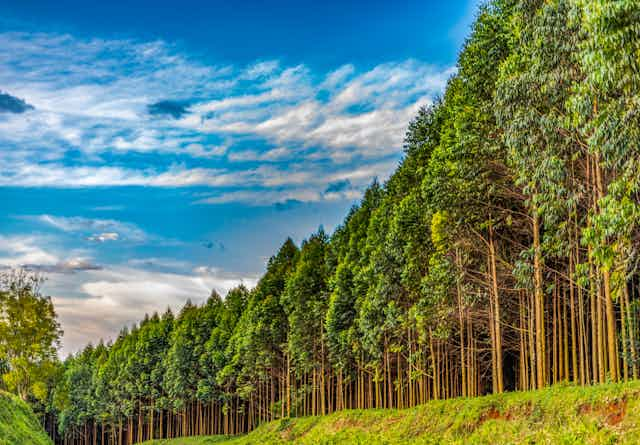As trees grow they remove carbon from the atmosphere. New forests can therefore play an important role in meeting the goal of keeping Earth’s temperature to 1.5°C above pre-industrial levels.
Governments and wider civil society are increasingly recognising these benefits. One important step was the 2011 launch of the Bonn Challenge to restore 350m hectares of forest by 2030. This is a major undertaking – the area is a little larger than the size of India.
Spurred by the necessities of drastically cutting emissions and removing carbon dioxide from the atmosphere to meet climate targets, many countries, including Brazil, India and China, have committed large areas to forest restoration. Adding up the Bonn Challenge and other national pledges from 43 countries across the tropics and sub-tropics – where trees grow fast – reveals that these governments have pledged to restore 292m hectares of degraded lands.
This very welcome news is, unfortunately, not all that is seems. Our new analysis, published in Nature, shows that implementing the current pledges under the Bonn Challenge will mean the 1.5°C climate goal is still missed.
More than half of the countries involved (24), covering two thirds of the pledged area, have stated what type of forest restoration they will do: 45% of the area is slated to become plantations of a single tree species (monocultures); 21% to agriculture that mixes trees and crops, known as agroforestry; and only 34% is given to restoring natural forests.

Such choices have profound carbon implications: for instance, our analysis shows that restoring natural forests over the whole 350m hectares of land would remove 42 billion tonnes of carbon by 2100. If instead we use the current proportion of pledges for plantations, natural forests and agroforestry applied to the whole area this is reduced to 16 billion tonnes (assuming that all new natural forests are protected to 2100). And if commercial monocultures were planted across 100% of the area just a billion tonnes of carbon would be sequestered.
Our research demonstrates that within these countries, land put aside for natural forests to return holds 40 times more carbon than plantations and six times more than agroforestry. This is mainly because natural forests continue to remove carbon from the atmosphere for many decades, whereas plantations are harvested every decade or so, which means almost all the carbon stored in the trees goes back into the atmosphere, as the plantation waste and wood products – mostly paper and chipboard – decompose.

To put these numbers into context, the recent Intergovernmental Panel on Climate Change Special Report on 1.5°C, noted that meeting this target requires 200 billion tonnes of carbon to be removed from the atmosphere this century. This colossal number is equivalent to the total emissions from 1800 to 2015 from the US, China, Germany and the UK combined. New forests and other land sequestration plans are expected to account for about one quarter of this carbon removal. At 42 billion tonnes of carbon uptake, restoring only natural forests across the entire Bonn Challenge area would clearly get close to this target.

But scientists have modelled a number of emissions decline “pathways” to limit warming to 1.5°C by 2100. All models require a reduction in emissions to net zero by about 2050. Yet, the average requirement of 200 billion tonnes of carbon removal hides wildly different levels of how much carbon will have to be removed directly from the atmosphere, a process known as negative emissions. The faster we reduce emissions from fossil fuels and deforestation to zero, the lower the level of negative emissions required.
The total scale of negative emissions deployment matters, because as well as forests the other main technology that is central to 1.5°C scenarios also has a huge land footprint. Bioenergy with carbon capture and storage is expected to capture, on average, around 130 billion tonnes of carbon via planting crops for biofuel that are then burnt in power stations. The carbon emissions are then captured and stored underground. It is expected that an additional area of one or two times the size of India is needed for bioenergy crops by 2050.
Competing climate priorities
Assuming food producing areas and old-growth forests are spared, this huge extra demand for land is most likely to displace restored forests. We estimate that if the restored natural forests under the Bonn Challenge and national schemes were converted to bioenergy crops after 2050, just three billion tonnes of carbon would be sequestered by 2100.
The solution here is that newly restored natural forests need protecting in order to protect the climate benefits they provide. Otherwise, one area of climate policy may wipe out the gains made in another.
Of all the negative emissions technologies available, allowing natural forests to return is safe, often not costly, and brings many other obvious benefits. But forest restoration can only play the critical role that it needs to if it means the same thing to policy makers as it does to everyone else: restoring areas back to largely intact largely natural forest. A new definition of “forest restoration” that excludes monoculture plantations is needed.
Our new research is part of a new interest in restoring ecosystems to help mitigate climate change. We have both signed an open letter published in The Guardian by top scientists and activists which calls for a well-funded programme to restore ecosystems to meet our 1.5C climate goal, under the banner of “natural climate solutions”. A new website elaborating on these plans notes that just 2.5% of mitigation funds goes to natural solutions, despite their promise.
Curbing climate change via restoring Earth’s ecosystems to their former glory could be a profound positive legacy of the 21st century, but not if governments and their advisers pretend that vast commercial monocultures of trees are forest restoration.


